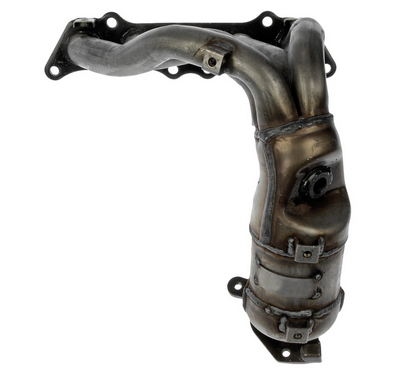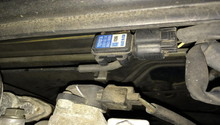Toyota Camry: Engine Codes Diagnostic Guide
Although not smart enough to fix itself, your Camry's engine lights do tell you what's going wrong and where to look.
This article applies to the Toyota Camry (1997-2011).
The computer or PCM (Powertrain Control Module) in your Camry is very smart. It senses all of the perimeters that the engineers put in place for the sensors that operate the drivetrain. When the PCM senses something out of the established perimeter, a trouble code is set in the PCM. Most of the time the check engine light comes on when a trouble code is set. Fortunately, you can pull those trouble codes and they will help you figure out what the issue is. An OBD-II (On Board Diagnostics 2) reader interacts with the PCM to pull the codes. They don't always make sense and don't always tell you exactly which part is bad but they will get you in the correct system. Let's take a look at some more common codes for your car.

Material Needed
- OBD-II code reader
Here's a breakdown of various engine codes on the Camry. But first, learn about your options with pulling these codes.
Pulling the Trouble Codes
There are many ways to get the PCM to give you the trouble codes that have been set. Most auto supply stores will hook a code reader to your car for free. Their reader may not get to the inner depths of the PCM but should catch the common codes. There are a few that seem to appear frequently and will probably be on your list. If you have to take a deep dive into your PCM, it may take a reader from the dealer or large independent repair shop. We will start with the common ones.

Pro Tip
It is possible to get an app for your Smart Phone to read the codes from the PCM. They vary in complexity and what they can read. You have to purchase an electronic module that plugs into the OBD port and transmits the information to your phone. It can be very interesting to see what it reads out.
Engine Codes
Evap Control System – P0440, P0441, P0442, P0446
Evap system codes are common. The Evap system consists of a charcoal canister that collects fuel vapors, associated tubing, gas cap, and various valves.
A P0440 could be as simple as the gas cap not being tight or defective. Next check to see that all of the hoses and tubing are sealed and not leaking. A hose near the Evap purge solenoid Vapor Switch Valve (VSV) could have been knocked off during service. Make sure the hoses are connected. Another VSV on the vent solenoid on the charcoal canister could also be not working. The charcoal canister is under your car near the gas tank. It is very difficult to get to even with a lift. A pressure sensor on the gas tank lets the PCM know if the system was evacuated properly, so if it is not working this code will set. Also if any of the wires going to the switches are damaged, then the valve may not be operating so they need to be checked, too.
A P0441 and P0442 also indicates that the Evap system is not purging properly. Check the same items as above.
P0446 points to the Evap system vent control circuit. This VSV is on the charcoal canister which means it's under your car in a bad spot. Unfortunately if it is this, the entire canister must be replaced for $300+. Even pros have to disconnect a lot of parts to pull it.

Figure 2. Tough place for a charcoal canister. 
Figure 3. Camry charcoal canister.
Pro Tip
Check your gas cap first thing. Paying someone just to tell you to tighten your gas cap is a terrible waste of money.
EGR Valve System – P0401, P1410
This code typically means EGR valve system malfunction. The EGR valve on your Camry is expensive to replace, but it is very robust and may just need to be cleaned.

- Typically the valve or gas pipe get carboned up and can be cleaned with carburator cleaner and a brush. This is not easy but much cheaper than a new valve.
- The modulator VSV (shown in Figure 4) can go bad.
- The hoses going to these also must be in good condition with no leaks.
Pro Tip
You may not notice a clogged EGR although it can cause the engine to ping. A leaky EGR will cause an unstable idle. Either of these can cause your car to fail an emission test.
Oxygen Sensor – P0130, P0133, P1133, P1135, P0141, P0171
Your Oxygen (O2) sensor monitors the exhaust gases to be sure the engine is running clean.
- Depending whether your car is a 4 or 6 cylinder you will have 2 or 4 of them.
- All of them must be replaced by one that is made for just that position.
- The specific code should point to which one is having issues.

Pro Tip
Since these are located on the exhaust they can be very difficult to get out. In the least you will need a specific socket to fit O2 sensors.
Catalytic Converter – P0420
Your convertor must function properly to pass an emission test.
- Your Camry has two or more converters that must operate correctly to meet emissions requirements.
- If you must replace one of them, it is a good idea to get an exact fit one for your car as a universal one may not interact properly with the system.

Pro Tip
As you can imagine, replacing either of these converters is expensive. Replacing them is zero fun unless you at least have an acetylene torch.
These are the most typical codes that your car may set, and there are hundreds more that could trigger. You can search the internet to find full listings of them.
Related Discussions
- Error Code P1410 '99 Camry - Camryforums.com
- Engine Light Codes P0440, P0441, P0446 - Camryforums.com
- P0171, P1133 - Camryforums.com






